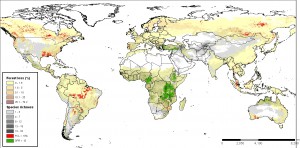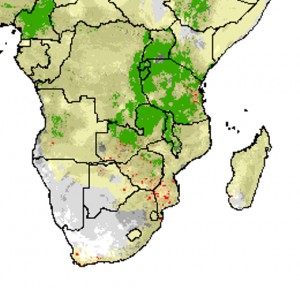- At last, sustainable clarinets!
- Hummus war gets serious. All that seratonin not helping?
- “Hearts of oak are our ships, jolly tars are our men.” Simon Schama on Quercus robur. Note to BBC: learn how to write species names.
- Pop quiz: Some 20,000 tons of this seed were delivered by Aztec farmers in annual tribute to their emperor, Montezuma. Now big in the US, according to NYTimes piece. From 1984.
Nibbles: Recognizing breeds, Cannabis in New Zealand, Farming systems data, Maize inbreds, Zinc in wheat, Markets for nature, Ramie, Milk and drought, ELBARN
- Computer program recognizes cattle breeds.
- NZ dope getting stronger? Maybe, and I hope so, but probably impossible to tell from this study.
- Need farming systems data?
- Psst, wanna know how to determine the essentially derived status of maize inbred lines?
- High zinc wheat works.
- Michael Jenkins of Forests Trends on using markets to save biodiversity.
- The phylogeny of ramie and its wild relatives sorted out. Sort of.
- Pearl millet landraces are the best under drought.
- Area action plans for local breeds in Europe are out.
Nibbles: CIAT, Apples, Poverty, Protected areas, Honey, Juniper, Irish oak
- Learn about CIAT’s reseach via the posters they put on slideshare. Couple on their beans and cassava genebank.
- Trying to speed up apple breeding.
- Biodiversity interventions find it difficult to fight poverty. How about agrobiodiversity interventions?
- More bad news: protected areas don’t work anyway. At least for trees in Burkina Faso.
- Boffins trying to spot contraband honey. There’s contraband honey?
- Gin drinkers told to start worrying.
- Forest of Belfast project to wind up, but not before finding really old oak.
Crop wild relatives mashed up with deforestation
The recent PNAS paper on deforestation has been getting a lot of attention. The data are available, and our mole at CIAT (thanks, Julian!) kindly mashed them up with the distribution of a selection of crop wild relatives (Cajanus, Cicer, Eleusine, Hordeum, Lens, Pennisetum, Phaseolus, Sorghum, Triticum, Aegilops, Vicia, Vigna, and Zea). Here’s the result. In red are shown area where forest loss is >10%. Green shows areas where >15 species in the above genera are expected to be found from niche models. You’ll have to click on it to see it properly.
Perhaps not surprisingly given the genepools involved, there’s not much overlap between crop wild relative richness and deforestation. These particular species don’t seem to have much to fear from the loss of forested land. Except for a few small areas in southern Africa, that is.
The picture would clearly be somewhat different if Julian had included wild cassava, rubber, apples or mangoes. I’m sure he will very soon.
Nibbles: Microlivestock, Urban ag, Ag info, School meals in Peru, Agrobiodiversity indicators, Nature special supplement, Extension, Breeding organic, Forgetting fish in China, Deforestation, Russian potatoes, Fijian traditional knowledge, Megaprogrammes
- FAO slideshow on Egyptian rabbits.
- Journal of Agriculture, Food Systems, and Community Development calls for papers on urban agriculture. Will some look at the intersection with art?
- And IAALD re-launches its journal.
- “…students receiving online encouragement from the national soccer star reported going to bed at night looking forward to receiving their iron supplements the following morning.” Great, of course. But why not iron-rich foods?
- Speaking of which, there’s a new FAO publication on “Foods counting for the Nutritional Indicators Biodiversity.” No, I don’t quite understand it myself. Something to do with what foods count towards CBD biodiversity targets. Well, it’s the International Year of Biodiversity, after all.
- Indeed it is. And Nature makes the most of it. See what I did there? No agriculture though, natch.
- Extension gets a forum?
- Biotech can be useful in organic farming? Say it ain’t so!
- More evidence of shifting baselines in people’s perceptions of biodiversity. How quickly they forget.
- Will they forget what forests look like?
- The Vavilov Institute potato collection needs a thorough going over. Taxonomically, that is.
- Making salt in mangrove ponds in Fiji. Nice video. Not agrobiodiversity, but it’s my blog and I like seeing Fiji on it.
- CGIAR abandons agrobiodiversity? Say it ain’t so. Anyone?
- Speaking of megaprogrammes, there’s going to be one on agricultural adaptation to climate change, right?
- “So, how does huitlacoche taste? Does it matter?? LOOK AT IT! I guess it would be fair to say it doesn’t taste as truly horrible as it looks. The flavor is elusive and difficult to describe, but I’ll try: ‘Kinda yucky.'” Don’t believe him! And read the rest.

